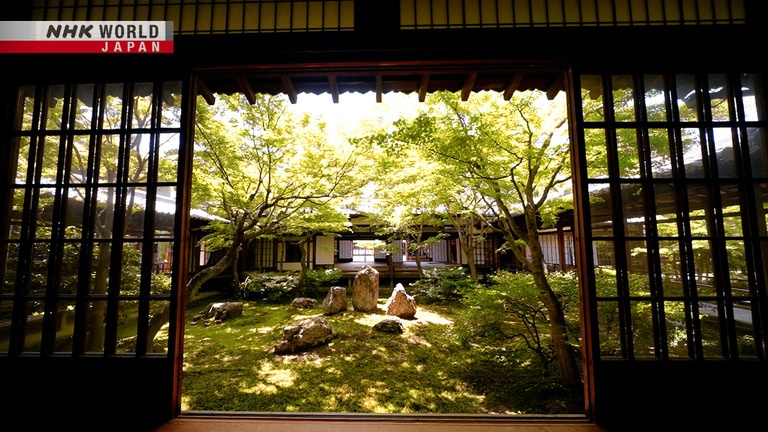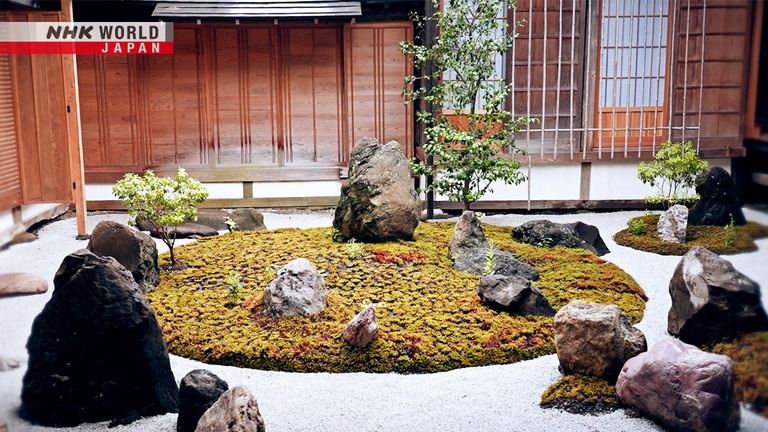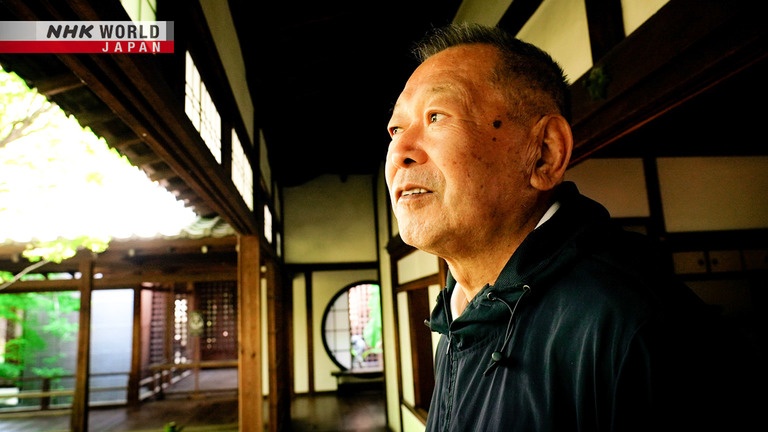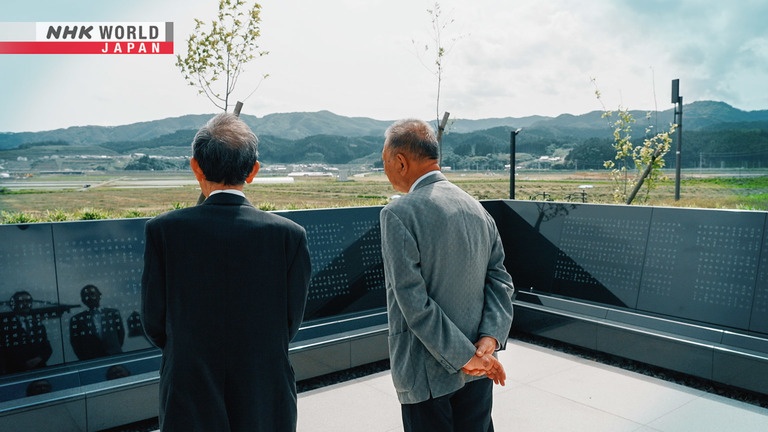Master Gardener - Kitayama Yasuo
Kitayama Yasuo is a 74-year-old master gardener. He has created over 70 of Japan's famous gardens, and receives commissions from all over the world. His specialty, the traditional rock garden, involves the careful manipulation of light and shadow. Rocks and pebbles are used to represent water. His final major project is in a city devastated by the 2011 Great East Japan Earthquake and Tsunami. We follow Kitayama as he works hard to create a garden where people can heal, through love for life.




Transcript
FRONTRUNNERS
Even the smallest gardens deserve to sparkle.
I try to treasure all elements, integrating both stones and plants.
I want to create a garden befitting the living and the dead.
I can't wait to get started.
Master gardener
Kitayama Yasuo
(Kyoto)
Founded in the year 1202,
Kyoto's Kenninji temple is the city's oldest Zen Buddhist place of worship.
At the heart of the temple complex is a hidden treasure.
A traditional Zen garden named Cho-on-tei.
It was created in 2005 by master gardener, Kitayama Yasuo.
Designed to convey the same sense of beauty from all viewing angles.
It's very easy on the eyes.
Very soothing to look at.
This is my favorite place
because right now the sun is just the center of the stone.
So, I feel like it's very sacred, like there's a spirit here.
And Kitayama continues to tend this garden through the changing seasons.
Which branch is the longest?
This one.
We can lose that. Cut it off.
Trees hate to be pruned too gingerly.
The question is how we as humans can shape the garden.
He may seem to be pruning willy-nilly,
but we take care to preserve the shadows, to let light in,
and consider the branches' future growth.
We have to have all that mapped out.
Without light, a garden will die.
Another of Kitayama's gardens
can be found to the east of Kyoto, at Kodai-ji temple.
It was founded in the 17th century
by the wife of Japan's great unifying leader, Toyotomi Hideyoshi,
as a memorial to her husband.
In front of the main hall is Hashin-tei,
a garden designed by Kitayama in the 80s.
This white gravel represents water.
In all, Kitayama has overseen some 70 gardens across Japan.
He also has five creations overseas,
including the UK, US, and South Africa.
We join him as he embarks upon a new project.
(Shibukawa, Gunma Pref.)
Fukuzoji Temple in Gunma Prefecture was founded in 1388.
Good morning!
At your service.
The chief abbot is Yokoyama Wako.
Here's the garden we spoke about.
I see. Right here.
This small garden was originally a labor of love by Yokoyama's predecessor.
But with things getting overgrown, it is time for an overhaul.
We want something people may find somewhat soothing,
or calming, to look upon.
Something that they might want to come back and see again.
That would make us very happy.
I believe that even the smallest gardens deserve to sparkle.
Back in Kyoto, Kitayama starts to plan the new garden for Fukuzoji.
Kojima-san. I'm here to see some trees.
What are you looking for?
Winterberry.
This plantation specializes in trees for traditional gardens.
Here is our largest winterberry tree.
Looks perfect.
The red berries are key.
This holly species is tall and slender, with eye-catching berries.
But this is nice, too.
We have three pomegranate trees to choose from.
I'm torn between the pomegranate and the winterberry.
Next, Kitayama heads to his own stone yard.
With rockery a key part of his style, he keeps a carefully curated selection.
This is bluestone from Shikoku,
though the blue can be a bit hard to discern.
This one's a little pale in color.
It's from Kurama, here in Kyoto.
As you can see, I have a lot of different types of stone here.
This is my favorite kind of stone, from the mountains.
Mountain rocks can be very lumpy,
but I feel those unique details provide a source of interest.
Put that on top of there.
And this one, too.
They use smaller stones to earmark his chosen items.
This is my treasure trove.
I can't wait to get started.
I wish I could fly there now.
That's it for now.
Not far away is another Kitayama garden.
Hi there!
This is the home of artist, Nishino Yoichi.
Coming back here, the trees have really matured.
And so have the stones.
Kitayama created this garden 16 years ago.
And then, too, the process was filmed for a documentary.
Nishino's request was a garden
that showcased nature through the changing seasons.
I tried to create a quiet space,
one that would bring the feel of the mountains and the hills
into his daily life.
And now, all these years later...
My, this persimmon tree has grown.
It bears lots of fruit every year.
When the different flowers are in bloom,
you can see what birds and butterflies come.
It gives a real feel for the seasons.
And that everyday immersion in nature provides a lasting inspiration
that feeds back into Nishino's art.
I may have neglected it a bit.
Well, that's the best way.
Just watch over your garden and let it do its own thing.
After 10 or 15 years, a garden really comes into its own.
And I think that's exactly what's happened here.
It takes 100 years for a garden to really be complete.
The first 30 years establish its character, and over the next 70,
that grows into something even more special.
Born into a family of Kyoto gardeners,
Kitayama Yasuo loved temples from an early age.
In 1971, straight out of college, he entered the family trade,
before setting up his own business at the age of 26.
His first major assignment came three years later at Entoku-in
a subsidiary temple of Kodai-ji.
Back then, the trees in this garden were densely overgrown,
moving Kitayama to cut down one 200-year-old camelia
he felt was in the way.
Here's the spot where it stood.
I felt proud of myself that the view had improved,
but the abbot didn't see things that way.
"Why did you cut down that tree?!" he said.
"Are living things so trivial to you?!"
"How can you blithely cut down a tree that's been here 200 years!"
It was real food for thought.
That's one of the most important lessons in my life to date.
One that I value greatly, even today.
June 2023, Kitayama is back in Gunma,
accompanied by trusted collaborator, Kudo Akio.
How's your wife?
She's doing well, thanks.
In fact, this will be Kitayama's first job back
after a recent stay in hospital.
Easy does it...
Yep, that's the spot. Line them up there.
Take your time with those weeds.
In his youth, Kudo spent 15 years as Kitayama's apprentice.
Can't have all these dandelions, can we?
But by the next day, their work has revealed something surprising.
I was shocked to find all these.
It's the queerest thing. I just wasn't expecting to see so many stones.
Some of them were buried under the soil.
Digging over topsoil has uncovered several surprisingly large
and attractive rock features.
And all that's even before the arrival of more stones from Kyoto.
Wow, look at all these.
These are some serious stones.
I didn't realize how big they were.
What a pickle.
The issue is size.
If we plonked three of those big stones here, they'd be too much.
Kitayama decides to work with the existing stones
and send the others back to Kyoto.
I was raring to go, too...
And Kitayama has also made the trip back to the ancient capital.
Welcome.
Hello there.
The usual: eggplant with beansprouts, and my usual "negiyaki," please.
Whenever things get tough, he always turns to his favorite meal for comfort.
This first job since his hospitalization has left him with much to ponder.
The stones I took to Gunma were too big,
and they didn't fit in with my usual vision.
So, I thought I'd better come back here to Kyoto to reassess the situation.
I'm looking for some smaller stones.
This yard specializes in vintage rockery and stonework.
I'll take this one.
And the one next to it.
Plus this, this, this, and this.
No substitute for intuition, huh?
It's vital to me. Instinct is key.
Hi there.
Got any andromeda?
Kitayama also makes another trip to his trusted tree stockist.
Just the ticket.
Nice and unassuming.
His new plan is to use smaller bushes to accentuate the existing stones.
I think we're going to end up with a very pleasant garden.
Rikuzentakata, Iwate Prefecture.
In March 2011, the coast was struck
by the Great East Japan Earthquake and Tsunami,
with over 1,800 lives lost, and over 3,000 homes washed away.
Wow, what a big plot.
Kitayama is working on a project to create a memorial garden here.
The idea dates back to 2012
when he designed a Japanese garden for the London Olympics.
It incorporated trees planted by people with links to this disaster-hit region.
Some had lost family members in the disaster.
Learning that, I began to wonder if there wasn't something I could do.
To promote the idea, Kitayama visited the mayor of Rikuzentakata.
My aim is a place for the souls of the dead and the living.
A place for them to gather.
The idea for the 10,000 square meter plot
is a series of spacious gardens connected by winding footpaths.
But while the land has been provided by the local authorities,
Kitayama is having to raise most other costs himself.
We're with you on this journey,
and ready to provide whatever support we can
to create something special.
Kitayama pays a visit to a memorial cenotaph near the scheduled site.
Hello there. Where have you come from?
I'm from here.
Oh, I see.
This local resident reveals that
he visits the memorial on an almost daily basis.
My plan is to create a garden here in Rikuzentakata.
A place to welcome lost souls, and those who were left behind.
We're going to build it over there, in front of the old high school.
My house was behind the school.
Oh really? What was it like here?
All washed away, not a trace left.
Some greenery would be good, because we lost all that.
I think it's a great idea.
I want to use the land we have
and the skills I have to create something special.
Today has strengthened my resolve.
Back in Gunma, work on the garden of Fukuzoji continues.
Good job, guys.
Well, it's all here at last.
The new stone features have arrived from Kyoto.
Kudo!
I don't want you to kill yourself winching stones down from the truck!
Don't let it drop. Pull this way!
They transport the stones along rails made from bamboo.
Kudo! Be sure to take care!
Loading them in under the temple foundations.
Pull! That's it!
Put it with the others.
OK, let's stand it up! Not too far or you'll break it.
I want to use the existing stones.
We certainly won't dump them.
We'll try to make space for them.
This camelia's been here ten years.
So, we need to figure out how to make the most of it.
I want to treasure all the elements,
both stones and plants, to find the perfect balance.
Don't just lay it down! I said dig it in!
It's twisted, damn it!
Stand it up facing this way! That's it, lean it this way! Good!
He's a towering presence to us.
Like Mt. Fuji.
But despite that imposing nature,
he's also a soft, supportive force.
Steadfast and comforting.
That's it. Slowly. There we go. That's it.
Today, the temple is hosting a Buddhist memorial service.
Meanwhile, Kitayama's team are at the moss-planting stage.
I have them pat down the moss by hand to add texture and undulations.
They also plant the modest andromeda shipped over from Kyoto.
And one of the mourners, a temple patron, drops by to check on progress.
I like a garden where you can just gaze out, idly daydreaming.
Of course, this is still a work in progress,
but I love all those little seedlings just poking through.
A few days later, and the garden is nearing completion.
A layer of white gravel evokes the impression of water.
This approach, known as "karesansui,"
is meant to capture the full scope of nature,
without the use of real water features.
The past ten days have seen a remarkable transformation.
And to close out the project,
Kitayama bestows the garden with a new name.
"Seibaku." It combines the characters for "sacred" and "waterfall."
It's a source of purifying energy.
And that cascades down onto us.
"Seibaku Garden." What a great name. Fantastic.
The stones are quite understated,
but my overall sense is of a raging waterfall.
Like the existing stones and the ones from Kyoto
are coming together to say "let's work together."
(Seibakutei)
So, what is it that motivates Kitayama Yasuo as a "frontrunner" in his field?
My main driving force is love.
That can be hard for people to grasp,
but I want to share that with people
through the medium of traditional Japanese gardens,
for them to enjoy looking at.
And my ultimate hope is that,
that will resonate and that they will take a deeper interest.